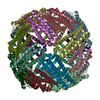+Search query
-Structure paper
| Title | Bacterioferritin nanocage structures uncover the biomineralization process in ferritins. |
|---|---|
| Journal, issue, pages | PNAS Nexus, Vol. 2, Issue 7, Page pgad235, Year 2023 |
| Publish date | Jul 20, 2023 |
 Authors Authors | Chacko Jobichen / Tan Ying Chong / Rajesh Rattinam / Sandip Basak / Mahalashmi Srinivasan / Yeu Khai Choong / Kannu Priya Pandey / Tran Bich Ngoc / Jian Shi / Jayaraman Angayarkanni / J Sivaraman /    |
| PubMed Abstract | Iron is an essential element involved in various metabolic processes. The ferritin family of proteins forms nanocage assembly and is involved in iron oxidation, storage, and mineralization. Although ...Iron is an essential element involved in various metabolic processes. The ferritin family of proteins forms nanocage assembly and is involved in iron oxidation, storage, and mineralization. Although several structures of human ferritins and bacterioferritins have been solved, there is still no complete structure that shows both the trapped Fe-biomineral cluster and the nanocage. Furthermore, whereas the mechanism of iron trafficking has been explained using various approaches, structural details on the biomineralization process (i.e. the formation of the mineral itself) are generally lacking. Here, we report the cryo-electron microscopy (cryo-EM) structures of apoform and biomineral bound form (holoforms) of the bacterioferritin (ScBfr) nanocage and the subunit crystal structure. The holoforms show different stages of Fe-biomineral accumulation inside the nanocage, in which the connections exist in two of the fourfold channels of the nanocage between the C-terminal of the ScBfr monomers and the Fe-biomineral cluster. The mutation and truncation of the bacterioferritin residues involved in these connections significantly reduced the iron and phosphate binding in comparison with those of the wild type and together explain the underlying mechanism. Collectively, our results represent a prototype for the bacterioferritin nanocage, which reveals insight into its biomineralization and the potential channel for bacterioferritin-associated iron trafficking. |
 External links External links |  PNAS Nexus / PNAS Nexus /  PubMed:37529551 / PubMed:37529551 /  PubMed Central PubMed Central |
| Methods | EM (single particle) |
| Resolution | 2.7 - 5.8 Å |
| Structure data | EMDB-33639, PDB-7y6f: EMDB-33640, PDB-7y6g: EMDB-33645, PDB-7y6p: EMDB-36137, PDB-8jax: EMDB-36139, PDB-8jb0:  EMDB-36140: Cryo-EM structure of Fe-biomineral from bacterioferritin |
| Chemicals |  ChemComp-FE2:  ChemComp-FE:  ChemComp-HEM: |
| Source |
|
 Keywords Keywords | METAL BINDING PROTEIN / Bacterioferritin / OXIDOREDUCTASE |
 Movie
Movie Controller
Controller Structure viewers
Structure viewers About Yorodumi Papers
About Yorodumi Papers













 streptomyces coelicolor (bacteria)
streptomyces coelicolor (bacteria)